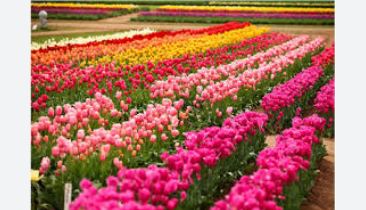PESHAWAR, Nov 17 (APP/DNA):Amid rows of young Gul-e-Dawoodi saplings glistening under the mild winter sun, 28-year-old plant seller Qadir Shah bends over yet another tray of delicate blooms.At a small nursery in Tarnab, the bustling hub of Peshawar’s floriculture trade, Qadir works against time by watering, trimming and preparing thousands of plants ordered by educational institutions including schools, colleges, universities and public offices in Khyber Pakhtunkhwa for December’s Gul e Dawoodi exhibitions.
With the annual flowers exhibition at historic Islamia College Peshawar around the corner, Qadir and his two helpers have little room for pause. “All the ordered stock will be ready by the end of this month,” he smiles, brushing soil off his hands. “We even import Gul-e-Dawoodi saplings from Pattoki, Kasur district, to meet the winter demand of our clients.”
For motivated Qadir, who inherited the business from his father, floriculture is not merely an income source but it is a legacy of colour, determination and hope. The soaring transportation costs, rising labour wages and plant losses due to harsh weather cut deep into profits, he reiterated.
“If floriculture is declared an industry, it would change everything positively in KP,” he said. “KP has enormous potential for this vital sector. This field can empower women and youth, and help Pakistan tap into billion-dollar global flowers markets.”
Floriculture experts agree that Pakistan’s soil and climate are among the best in the world for ornamental plants. However, floriculture remains one of the province’s most overlooked agri-economies.
Dr Abdul Rauf, Director General Agriculture Research KP, explained that floriculture covers not just the cultivation of ornamentals but also their marketing ranging from cut flowers and live plants to essential oils, scents and even medicinal by-products.
“In Pakistan, most flowers bloom during winter, when Europe and Central Asia mostly sink under snow,” he said. “This gives us a natural competitive advantage and our Govt must cash it.”
The returns, too, are striking for many poor farmers associated with this key business. While crops like potatoes or cherries earn farmers about Rs 80,000–100,000 per kanal, flowers can fetch Rs 1.5 to 2 million per kanal which is a key potential economic windfall often overlooked by our policymakers.
Global demand for cut flowers continues to rise by 10–15% annually, he said, adding Netherlands dominates the flowers export market with $3.9 billion, yet Pakistan, with larger arable land, cheaper labour and favourable climate, has not captured even a fraction of this blessed opportunity. “Pakistan just needs improved production technology and coordinated policies to promote this sector,” Dr Rauf stressed.
Dr Muhammad Naeem, former Chairman of the Economics Department at the University of Peshawar, believed that floriculture could transform Pakistan’s rural economy especially at a time when traditional crops are consuming over 90% of the country’s freshwater resources.
“Flowers require significantly less water than sugarcane or rice,” he said and added that they offer far higher returns per acre. For small farmers with limited land, this is a game changer for Pakistan.”
He reiterated that floriculture also creates jobs opportunities in value addition such as perfumes, essential oils and natural dyes which can absorb women and youth into the workforce.
However despite these advantages, the sector remains largely informal and underfinanced in Khyber Pakthunkhwa. Farmers face volatile prices and high spoilage due to inadequate cold storage and transportation. Many growers lack the technical support needed to meet market demands or combat plant diseases.
This paradox is especially visible in Pattoki Kausar, home to Pakistan’s largest flower market. Most growers there are small-scale, lacking the capital to build climate-resilient greenhouses or adopt drip irrigation systems.
“Climate change has made traditional farming riskier,” Dr Naeem added. “Floriculture offers resilience, but small farmers must be supported to withstand climate-related shocks.”
Experts unanimously emphasized the need for targeted policy action in KP. Integrating floriculture into provincial agricultural strategies, incentivising private investment in cold chains, and forming public-private partnerships can dramatically boost yields and quality of flowers in KP.
Strengthening extension services and offering specialised training can help growers meet global export standards at national level. Digital platforms can connect them with buyers directly, cutting out middlemen and increasing profit margins.
“Pakistan stands at a crossroads,” Dr Naeem said. “We can continue depending on water-thirsty, low-value crops or diversify into high-value, climate-resilient sectors like floriculture.”
In Nowshera, 32-year-old Sumbal Riaz has quietly built her own floral micro-enterprise from home. “I started with just a few pots,” she said. “Now I earn a substantial income.” Her young Gul-e-Dawoodi plants are transported to Tarnab, where they sell out quickly during winter.
Sumbal urges the KP government to provide interest-free loans to help women entrepreneurs expand their ventures. “With a little support, so many women can stand on their own feet,” she said.
According to Muhammad Diyar Khan, Project Director of the Billion Trees Afforestation Project, the KP government is working to support climate resilience and youth entrepreneurship through initiatives.
“Green jobs have already been provided to thousands of women and youth,” he said. “Floriculture can become another strong avenue for sustainable livelihoods.”
From Peshawar to Kasur, from Swat to Thatta, Pakistan’s natural environment offers the canvas of a thriving floriculture industry waiting to bloom. All it needs now is strategic support and the country’s rural communities may soon be cultivating not just flowers, but a more prosperous future.

















